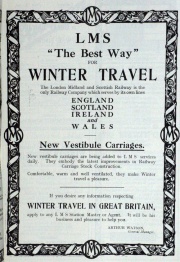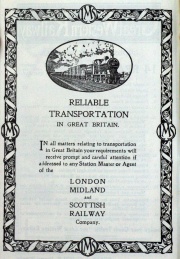London, Midland and Scottish Railway




The London Midland and Scottish Railway, (L. M. and S.) or (LMS) was created by the Railways Act 1921 from a number of Constituent Companies and came in to force on the 1st January 1923.
Constituent Companies
1923 The following companies made up the London, Midland and Scottish Railway as a result of the Railways Act 1921 and came into force on the 1st January 1923:
- Caledonian Railway (CalR) 1114.5 route miles
- Furness Railway (Furness) 158 miles
- Glasgow and South Western Railway 493.5 miles
- Highland Railway(HR) 506 miles
- London and North Western Railway (LNWR) 2667.5 miles
- Midland Railway (MidR) 2170.75 miles
- North Staffordshire Railway (NSR) 220.75 miles
Total Mileage of the constituent companies was 7,331 miles
1933 The arrival of the new Chief Mechanical Engineer William Stanier, who was head-hunted from the Great Western Railway by Josiah Stamp in 1933, heralded a change in the LMS. Stanier introduced new ideas rather than continuing with the company's internal conflict.
1938, the LMS operated 6,870 route miles of railway (excluding its lines in Northern Ireland), but it was not very profitable with a rate of return of only 2.7%.
WWII brought a further period of direct government control, and by its end a Labour government was in power and planning to nationalise the railways.
1948 Along with the other British railway companies, the LMS was nationalised and became part of British Railways.
Chief Mechanical Engineers
- George Hughes 1923-1925
- Henry Fowler 1925-1933
- Ernest Lemon
- William Stanier 1932-1944
- Charles Fairburn
- Henry Ivatt
General
1925 The London, Midland and Scottish Railway placed orders for nearly a hundred new engines in the Glasgow district. These engines formed part of the programme of new work announced by the company at the beginning of the year, and were built partly at the old Caledonian works at St. Rollox and partly at the works of private builders. The expenditure on their construction, amounted to a total of about £750,000. These orders have followed closely upon the announcement that the company had placed a contract with Hurst, Nelson and Co., of Motherwell, for seven five-coach trains, at a total cost of about £100,000, and another one with Pickering and Co., of Wishaw, for thirteen coaches.
1925 Since the London, Midland and Scottish Railway was formed, it has made provision for the construction of 2,303 new passenger coaches, 45,000 goods wagons, and 4,815 passenger and goods locomotives. [1]
1927 Mr H. G. Burgess the general manager retired on the March 31st, after fifty-three years' service. His office wasn't continued, but Sir Josiah Stamp, the president, had the assistance of four vice-presidents - Messrs S. H. Hunt, J. Quirey, J. H. Follows and R. W. Reid.[2]
1930 With the passing of the Railway Companies Road Transport Acts, it became clear that the bus companies could face stiff competition so the management of the National Omnibus and Transport Co led the way in negotiating with the main railway companies, forming 3 joint companies, the last of which was the Eastern National Omnibus Co formed with the London and North Eastern Railway and the London, Midland and Scottish Railway[3].
1935 Introduction of non-condensing turbine locomotive - Turbomotive
1936 David MacBrayne Ltd and the London, Midland and Scottish Railway Company purchased the steamers and goodwill of Williamson-Buchanan Steamers Ltd and of Turbine Steamers Ltd[4]
1948 Acquired by the British Transport Commission on nationalisation of the railways.
See Also
- Railways: An Outline
- London, Midland and Scottish Railway Constituent Companies
- Railway Companies not Grouped in 1923
Sources of Information
- ↑ The Engineer 1925/04/03
- ↑ The Engineer 1926/11/05
- ↑ The Times, Apr 16, 1930
- ↑ The Times, Oct 05, 1935
[1] Wikipedia







































































